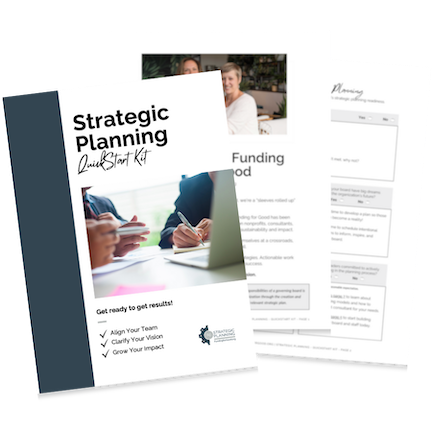At first glance, the difference between a fundraising plan and a strategic plan seems pretty obvious. One is about fundraising. One is about strategy.
But what about a strategic fundraising plan? Or developing a fundraising strategy? What do you call it when your strategic plan also delves into revenue streams and fundraising strategies?
The truth is strategic plans and fundraising plans should be closely intertwined. Let’s delve into how.
Fundraising Plan vs Strategic Plan
At its most basic level, a fundraising plan details how much you need to raise to meet your organization’s operating budget and your strategies to do so. A strategic plan, on the other hand, outlines a 3-5-year vision for your organization, including goals, objectives, strategies, and benchmarks for success.
If your strategic plan provides a roadmap for your organization’s future, your fundraising plan details how you’re going to pay for the journey.
Are you ready to start the strategic planning process?
What do you need to make a fundraising plan?
One important note is that a fundraising plan should always be created with an eye toward future years. Why?
-
- Your organization should always have at least 3-6 months of cash on hand to cover operating expenses. That means you’re raising funds for the future, not for tomorrow.
- Grant terms don’t follow calendar or fiscal years. You could be spending half of a grant one year and the other half the next year.
- Individual giving often ramps up at year-end. Both major gifts and small dollar donations may all arrive in November and December. To avoid a cash crunch, you’ll want to track when you expect income the rest of the year.
- Ongoing expenses, like salaries or office rent, don’t stop at the end of a year. Once an organization hires a new staff member or signs a long-term lease, you’ll want to plan for how to cover those costs for at least a year out.
In order to craft a solid fundraising plan, you’ll need a few pieces of information:
-
- Your organization’s current annual operating budget. If your organization has grown in recent years, you’ll want to compare year-over-year growth so that you can project fundraising needs for the next 1-2 years.
- Your organization’s annual revenue for the last 1-2 years. You’ll want details of revenue by channel—such as individual giving, foundation grants, corporate giving, events, etc. You’ll also want the details of all major contributions, whether individual or institutional. This should include donor name, gift amount, gift purpose, gift date, and grant term if applicable. Having two or more years of data can help you identify consistent donors and spot drop-off donors that could be re-engaged.
- Projected costs for major new expenses planned in the next 12-24 months. For example, if your organization is planning to double the size of the communications team over the next year, your fundraising plan should reflect those future costs.
Read more: 5 Ways to Boost Fundraising with a Strategic Plan
What format does a fundraising plan take?
Surprisingly, fundraising plans don’t have a set format. Some are spreadsheets while others are narratives. Increasingly, online productivity tools are also creating templates for fundraising plans. But a fancy format doesn’t necessarily mean better results.
At minimum, your fundraising plan should detail:
-
- How much income you plan to raise from each of your major revenue streams. For example, major individual donors, foundation grants, events, and membership dues.
- Which major donors make up these totals. This will help you develop a donor management calendar for major grants and gifts.
- How much of your projected income is committed, likely/renewal, or in an earlier prospect stage.
- Your plans for an ongoing donor relations strategy to keep donors engaged. Read more: Donor Relations Strategy: Where to Begin.
- Projected fundraising costs. For example, the costs of transitioning to a new donor database, traveling for donor meetings, or putting on a major event.
How a Strategic Plan Can Help
Creating a fundraising plan can feel overwhelming. There are dozens, if not hundreds, of moving pieces. And your staff and colleagues are counting on you to raise the organization’s budget—and pay their salaries!
Luckily, a strategic planning process can make fundraising smoother and more successful. That’s because a strategic plan provides valuable insight into the future. You’ll know where your organization is going over the next 3-5 years and what it may cost to get there. You’ll be able to quickly identify gaps, vulnerabilities, and opportunities for fundraising growth. Instead of reacting, you’ll be able to plan ahead.
Plus, your strategic plan itself will quickly become one of the best tools in your fundraising toolbox.



